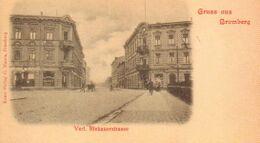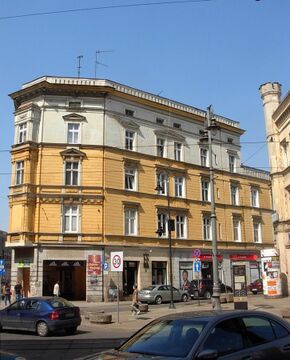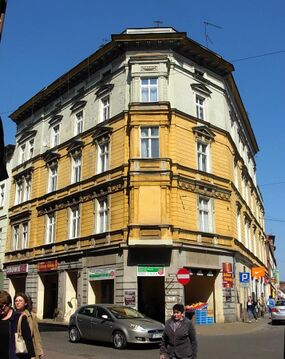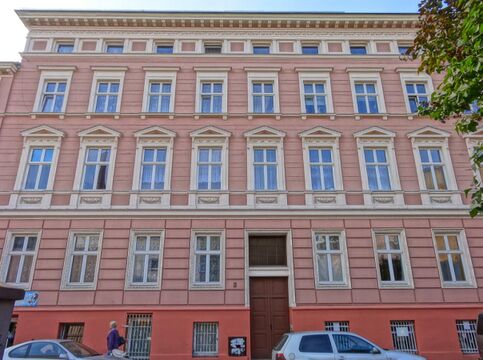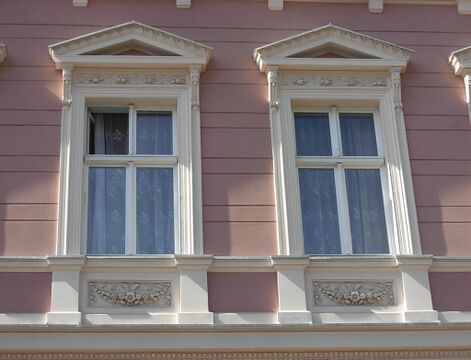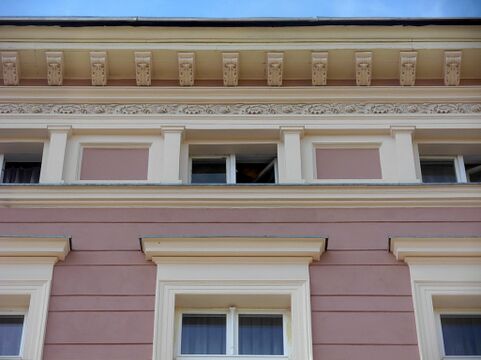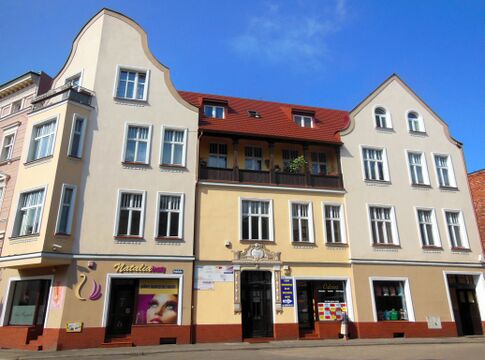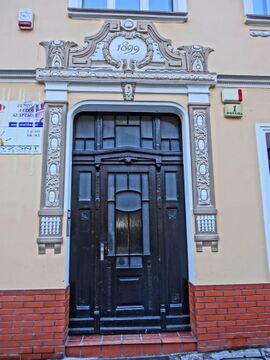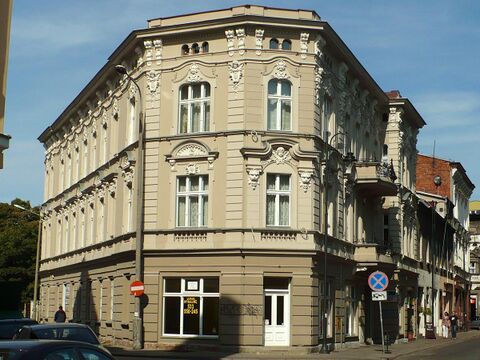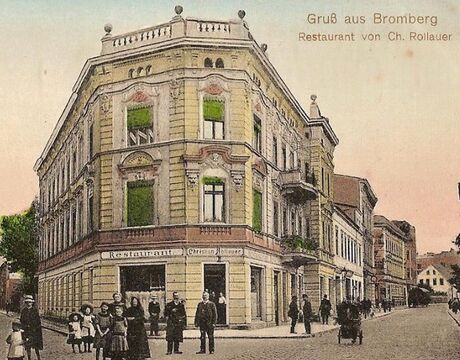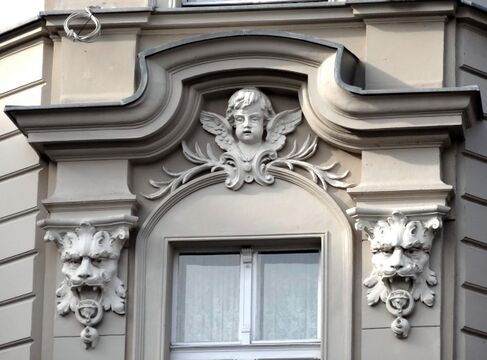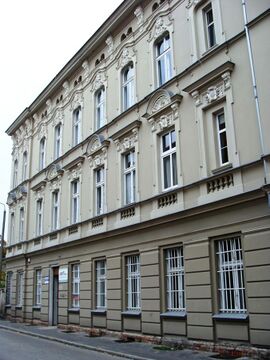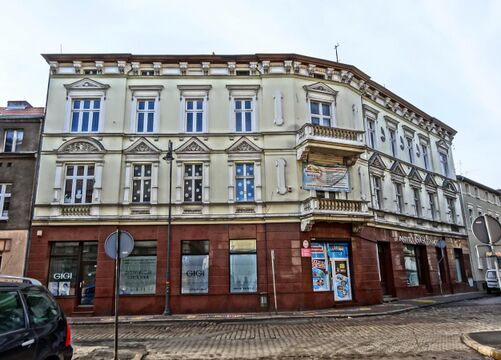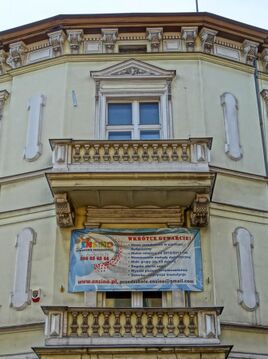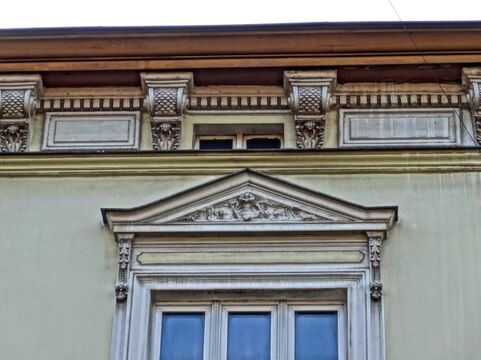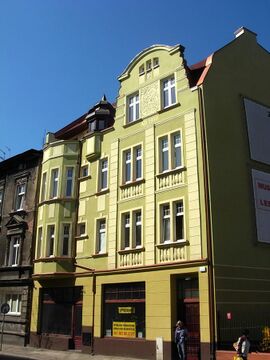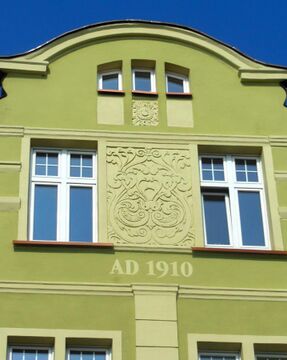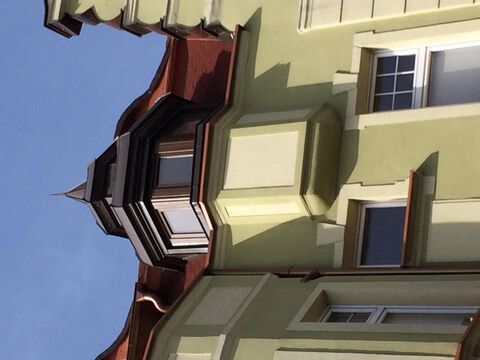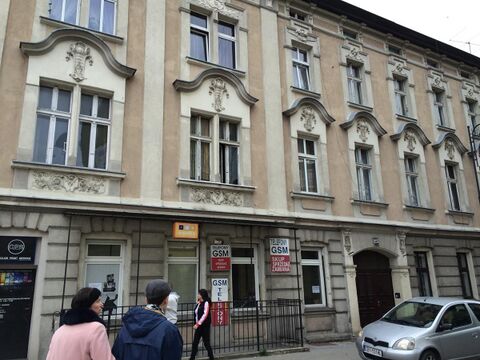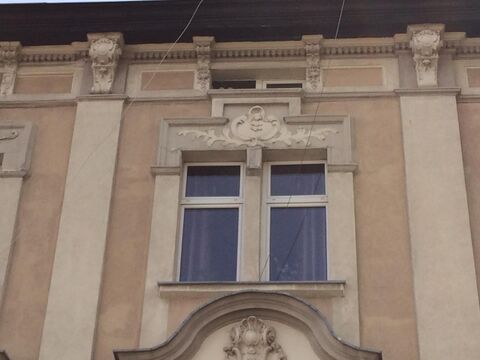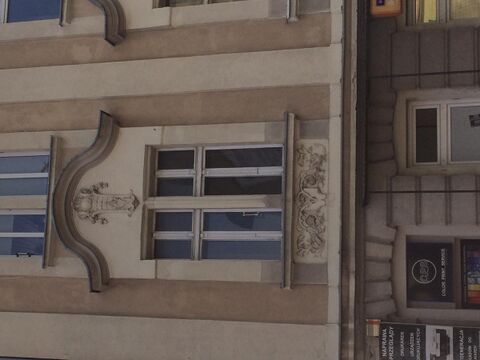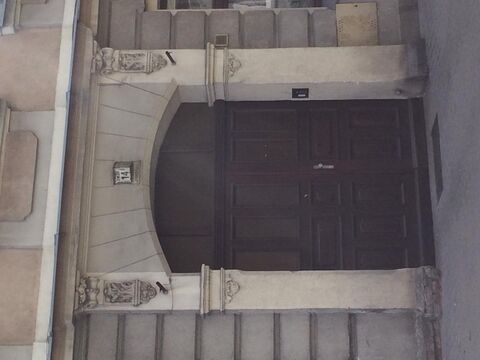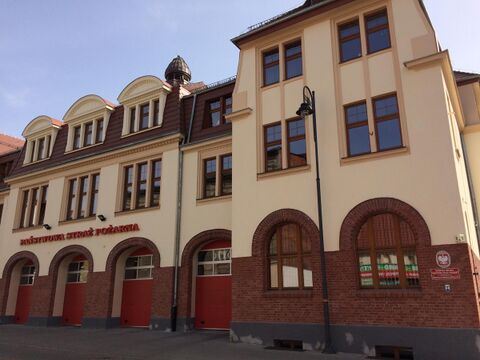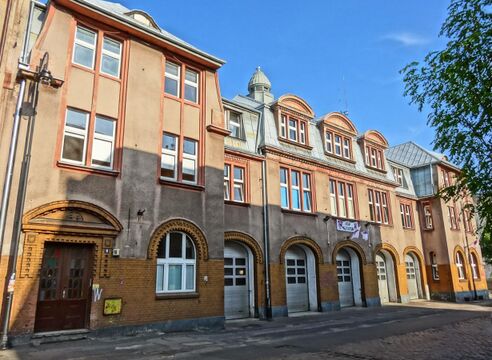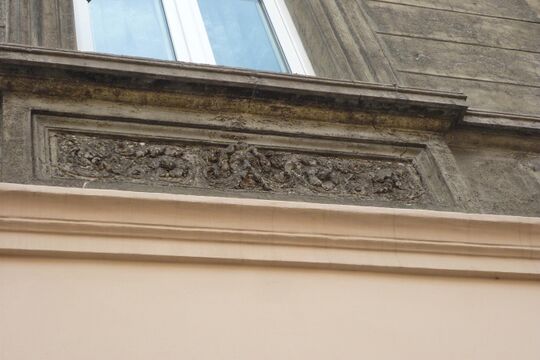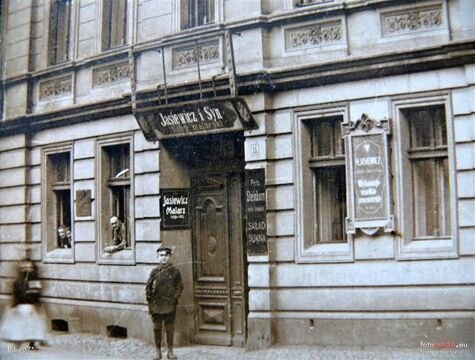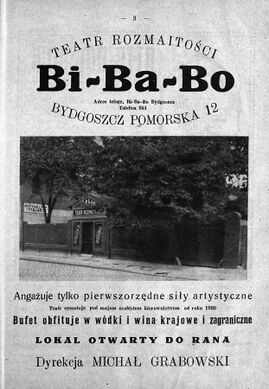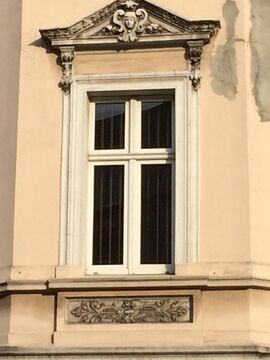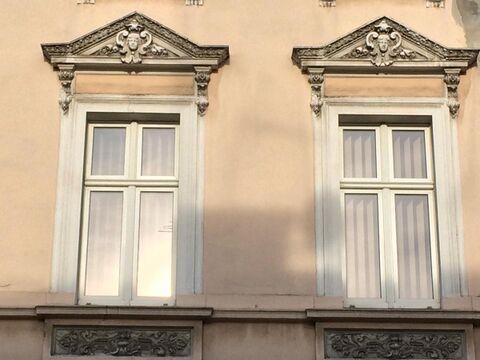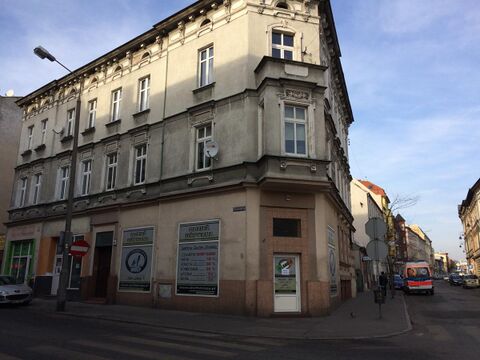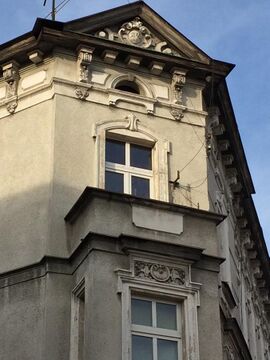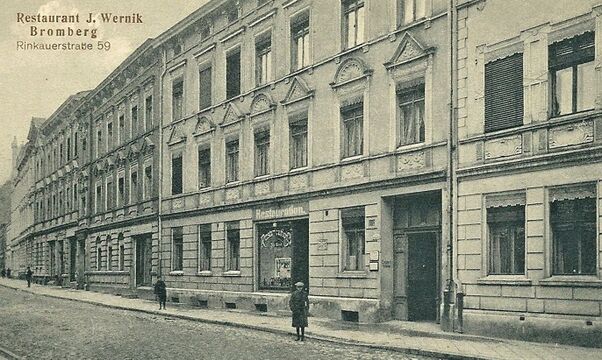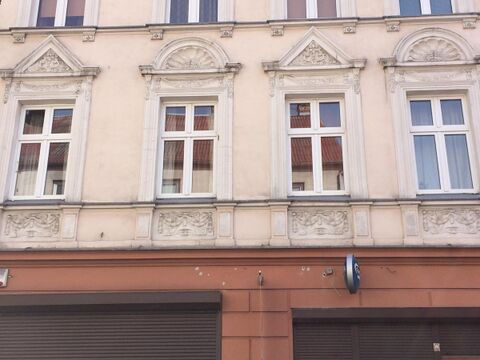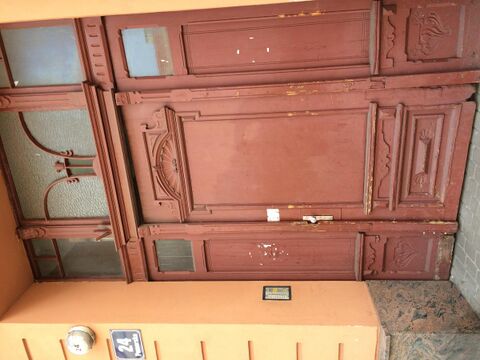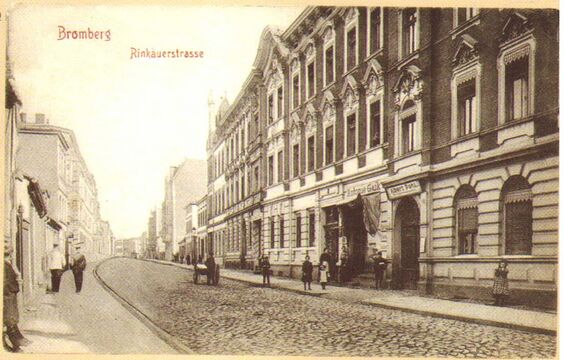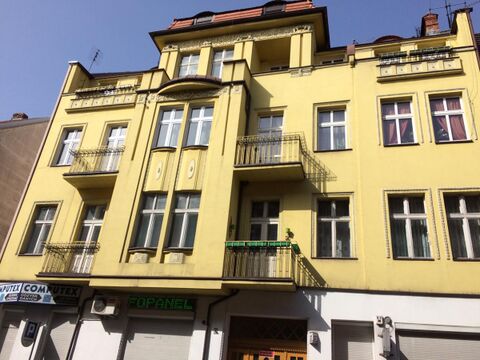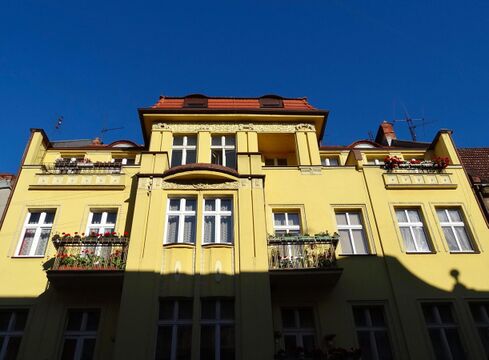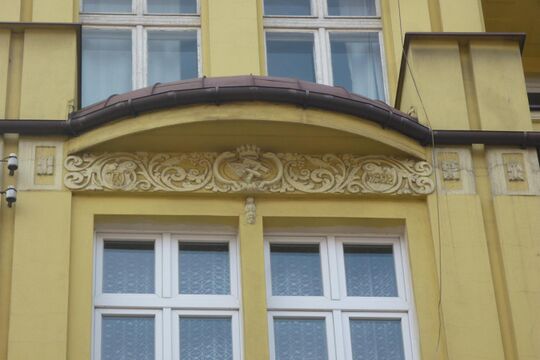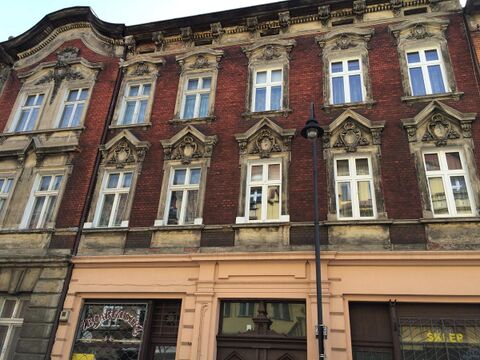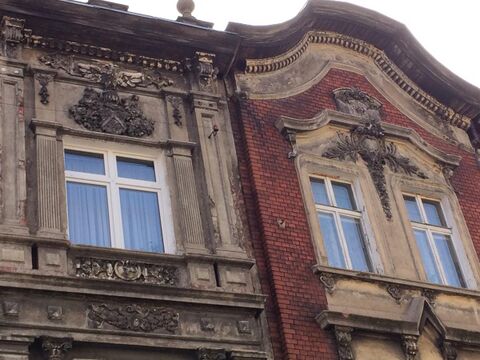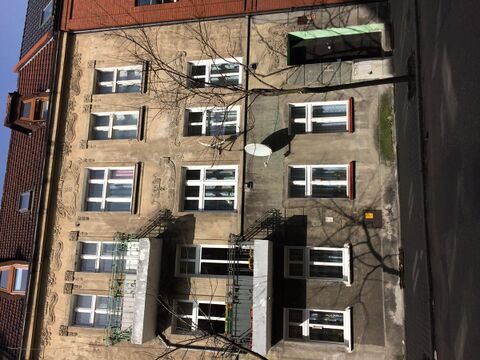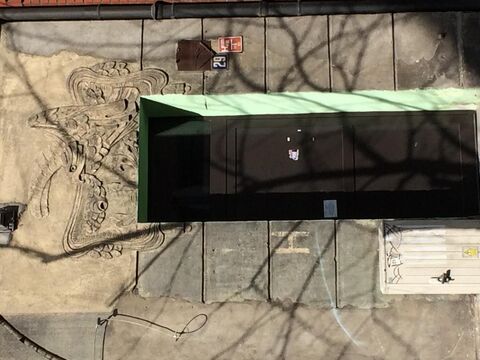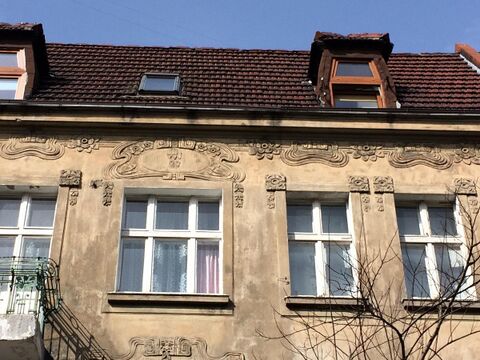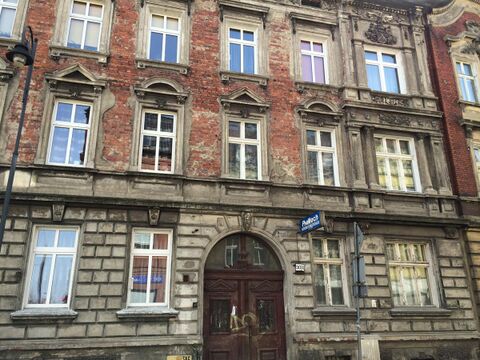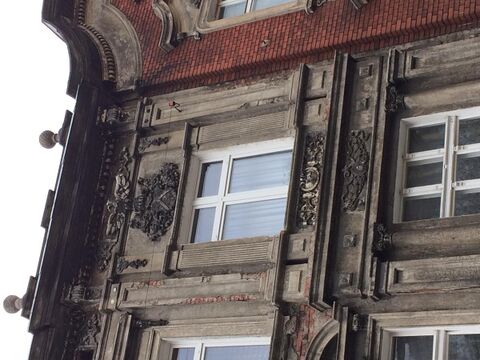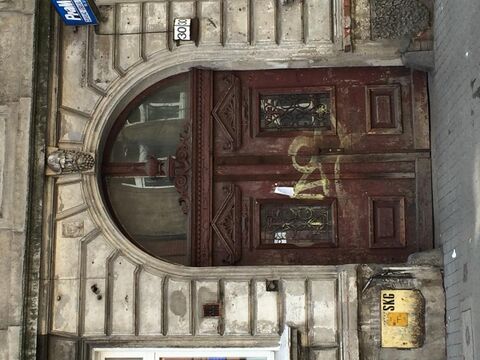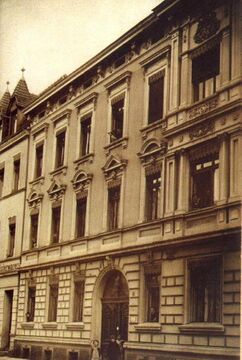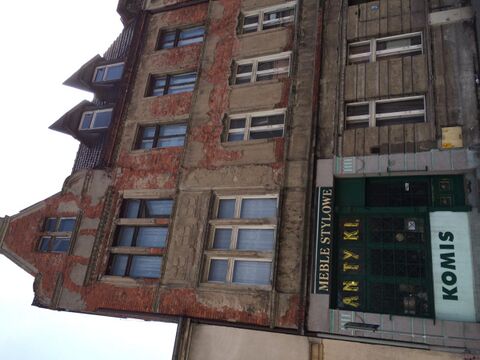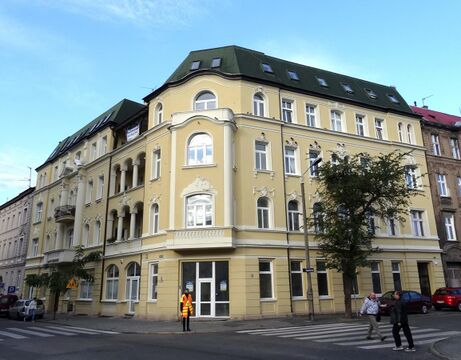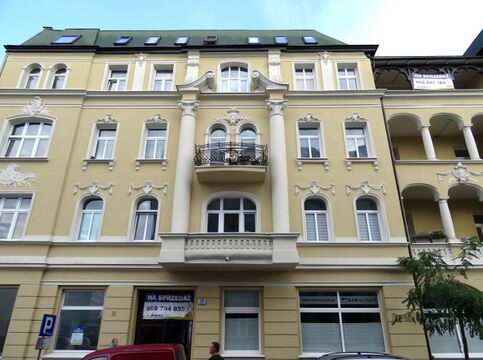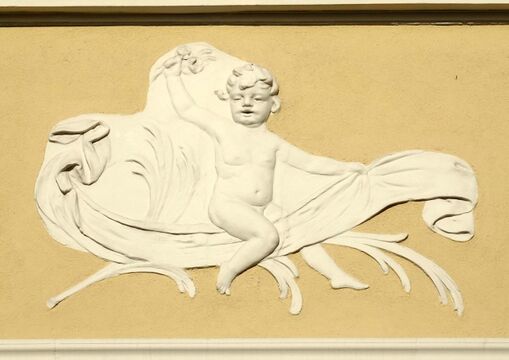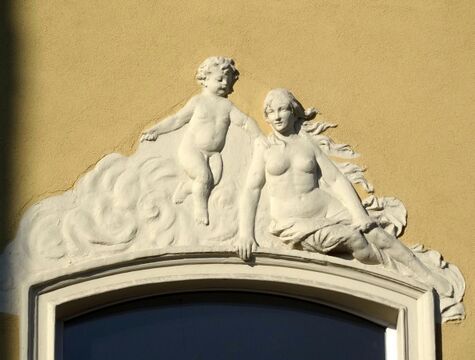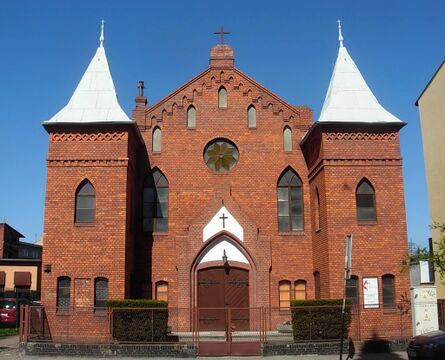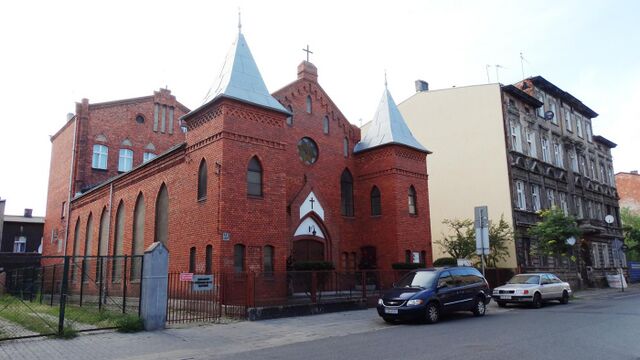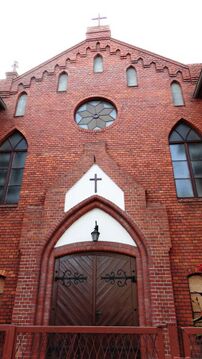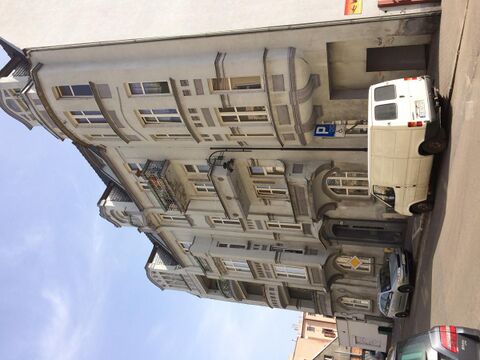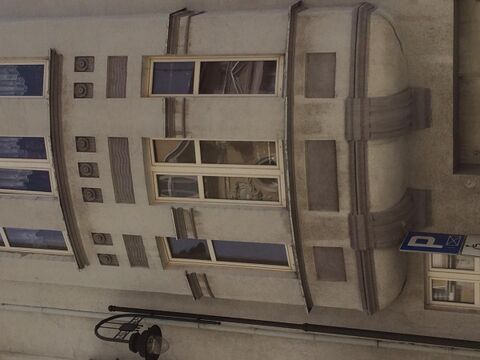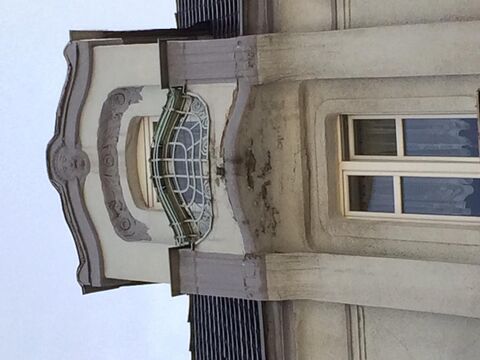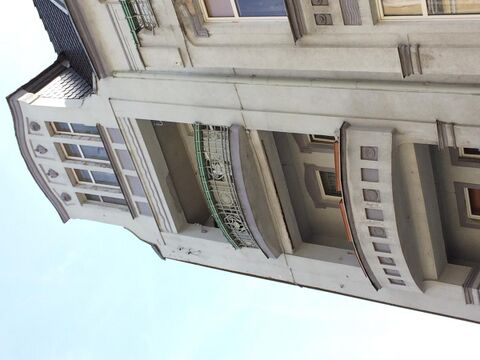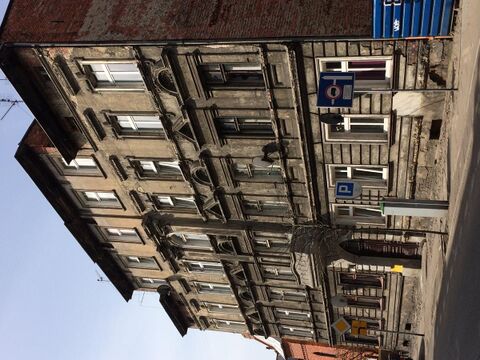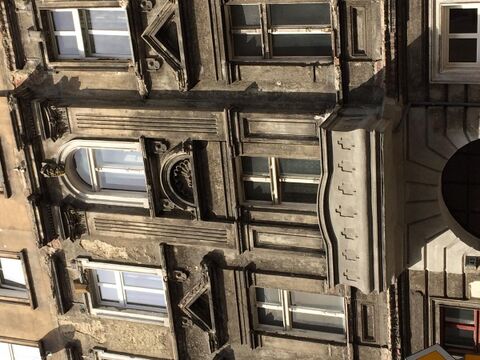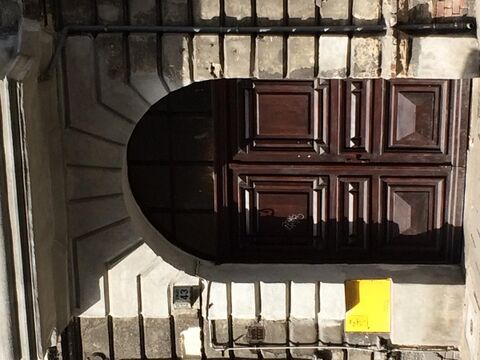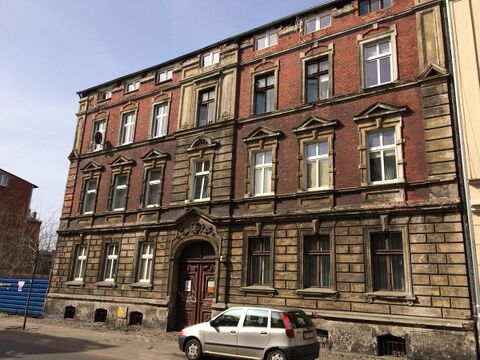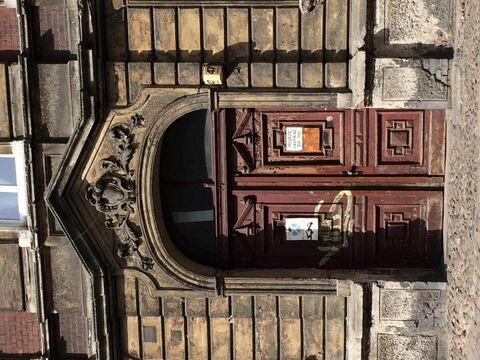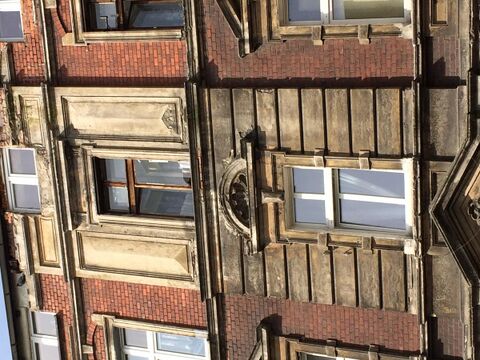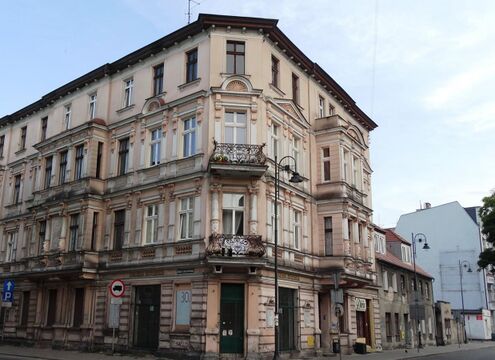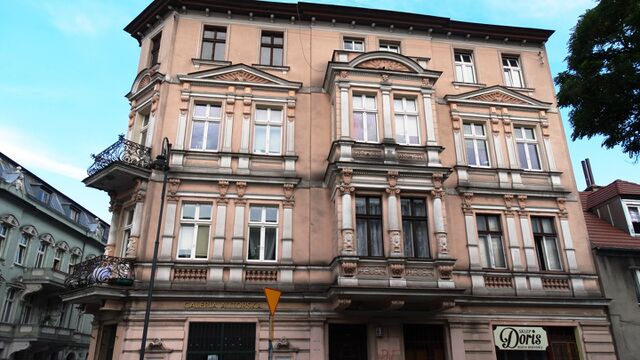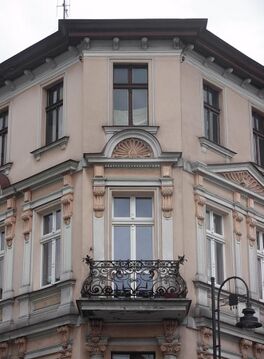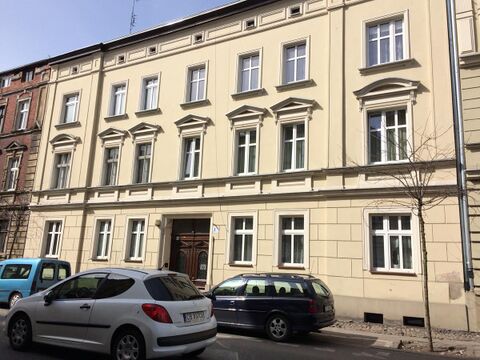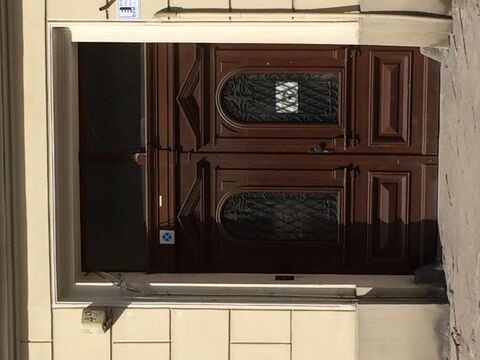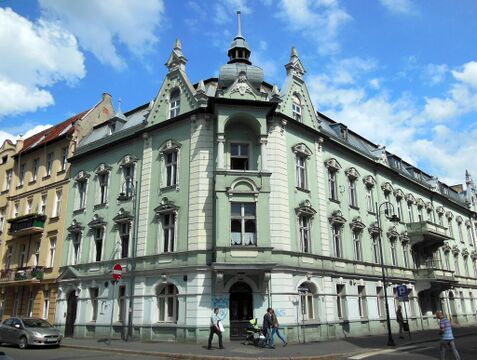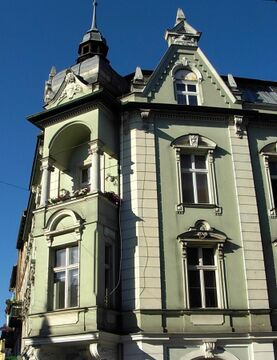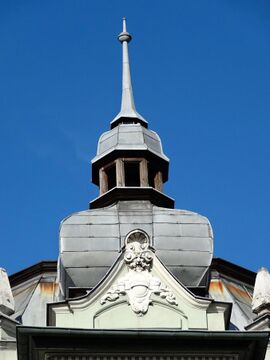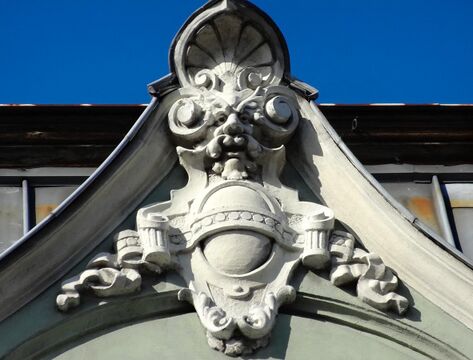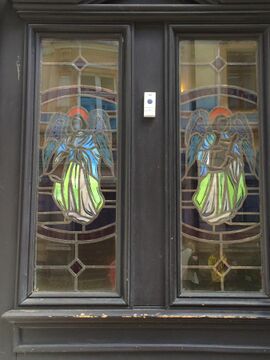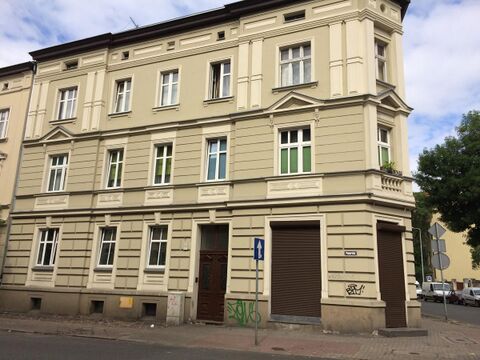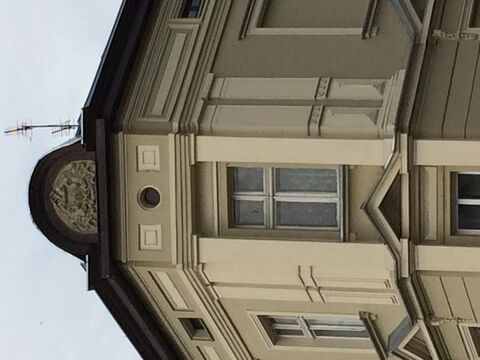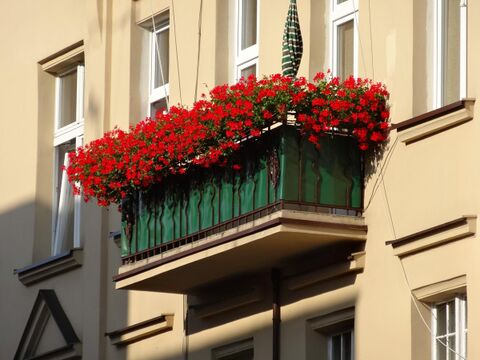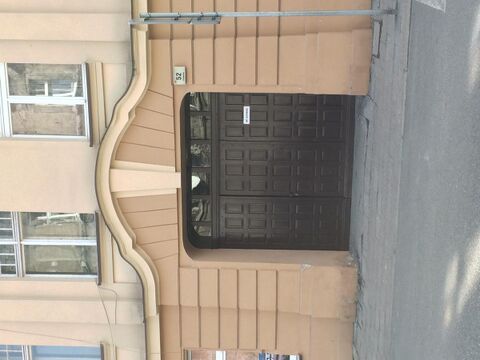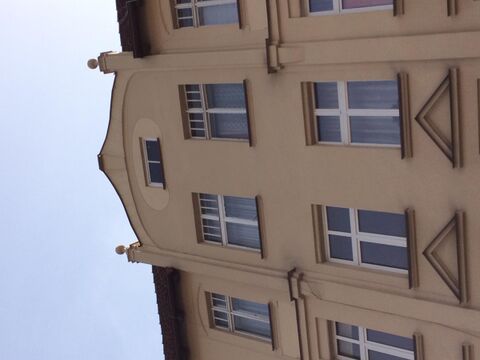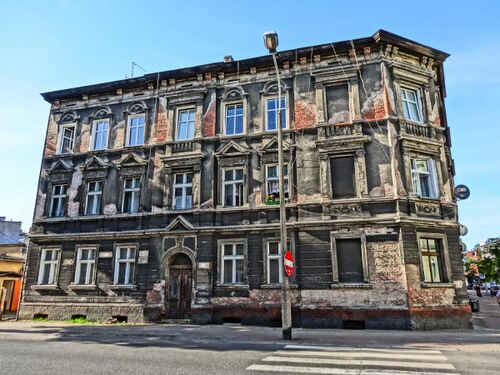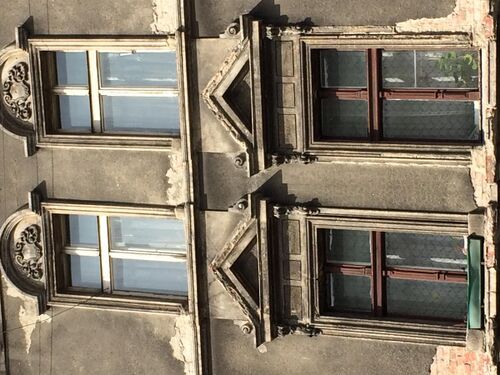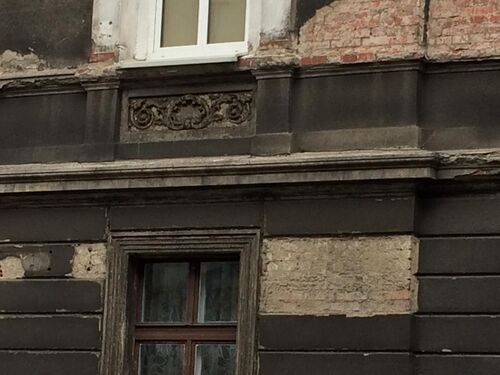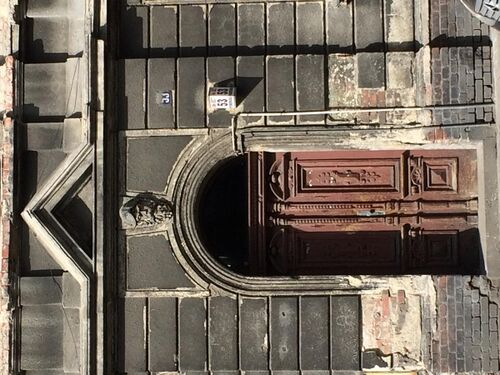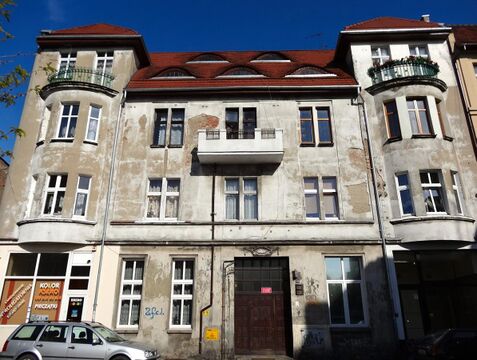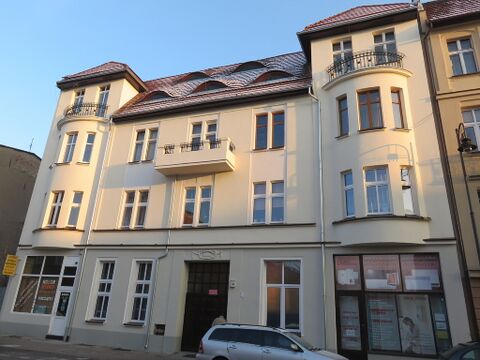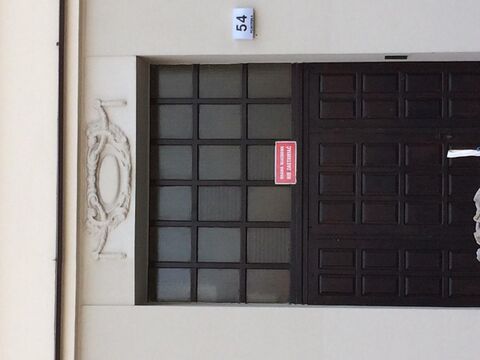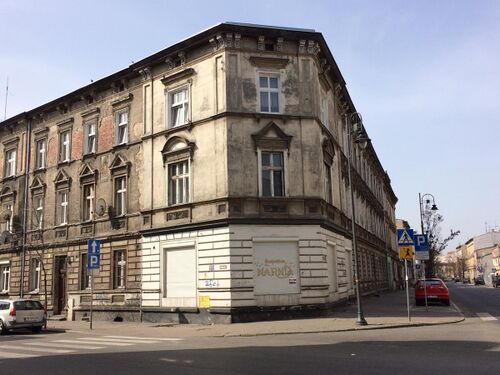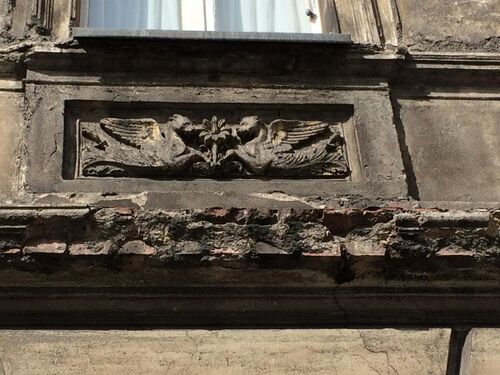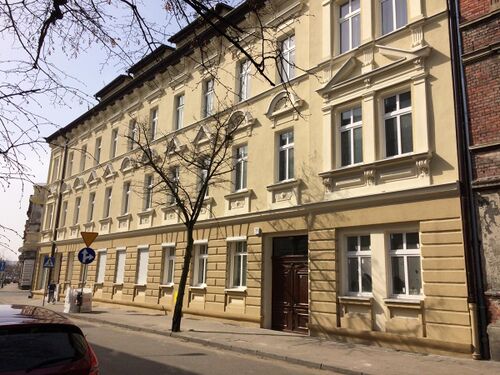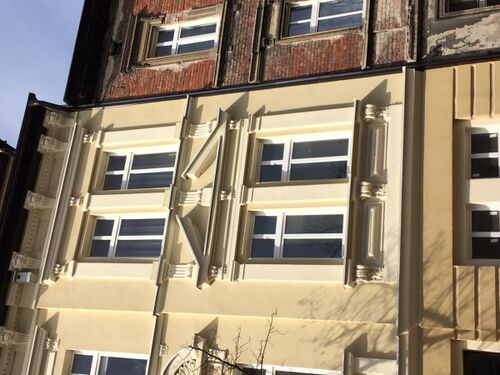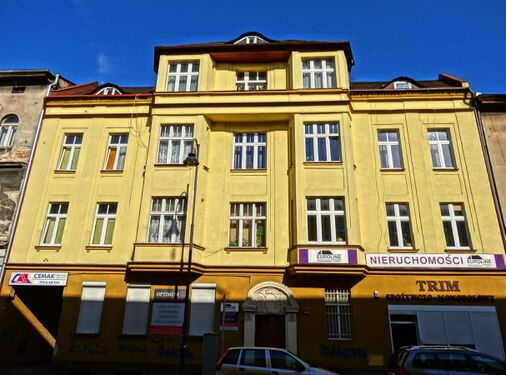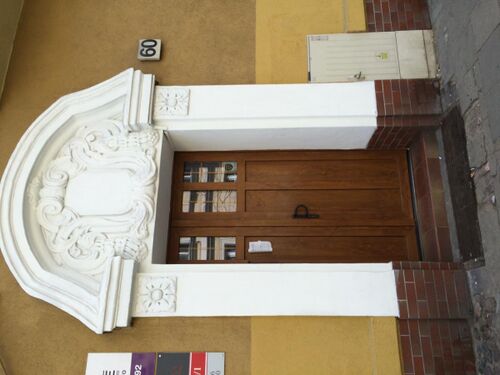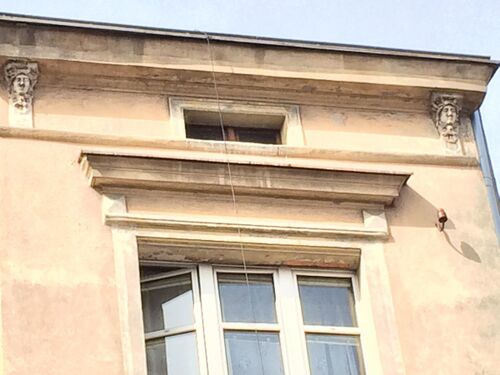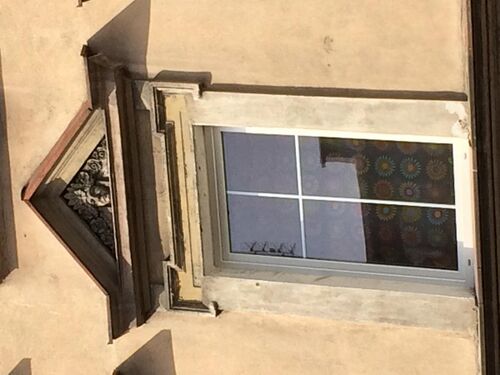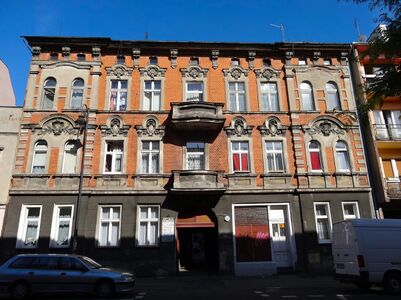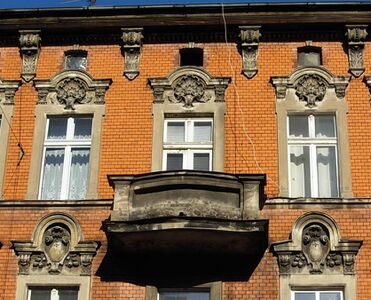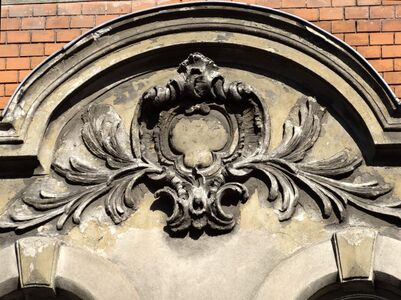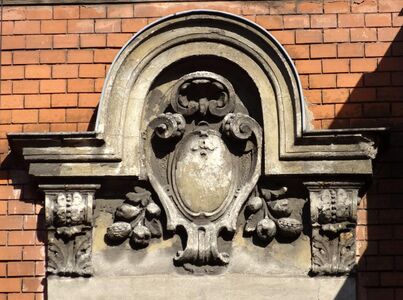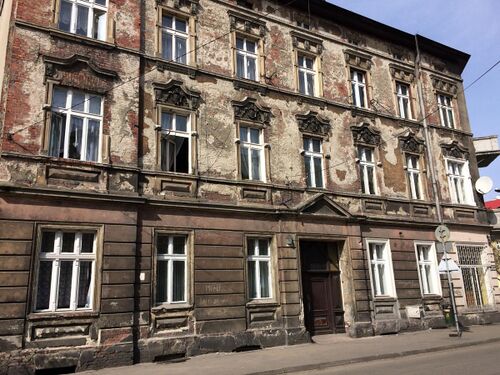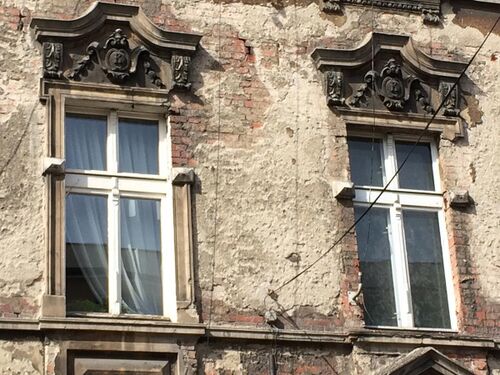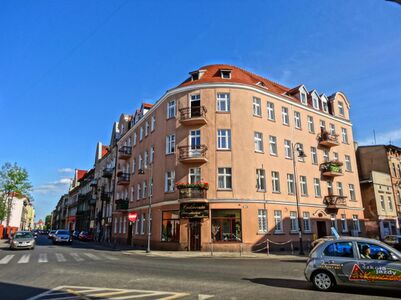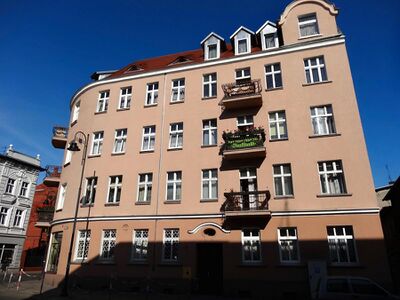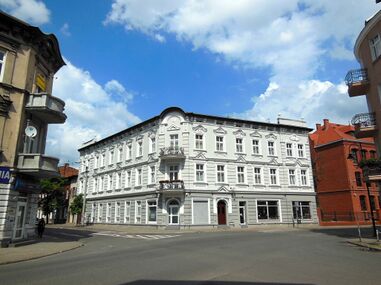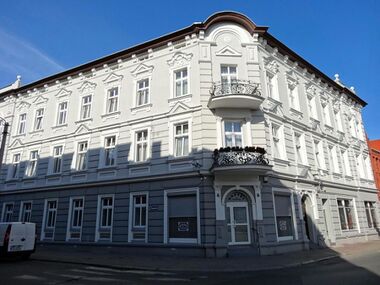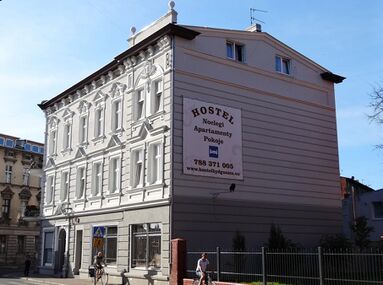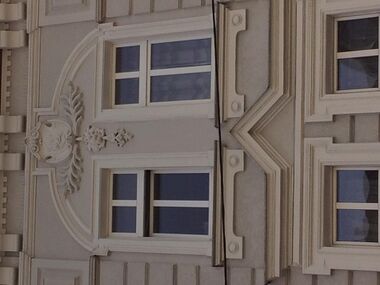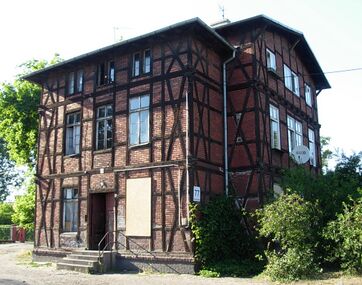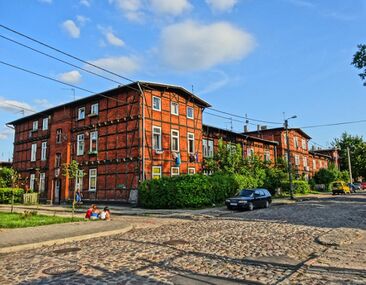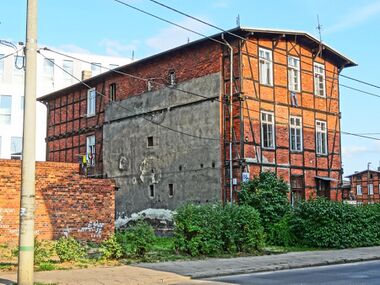Pomorska Street in Bydgoszcz
Topic: Social
 From HandWiki - Reading time: 25 min
From HandWiki - Reading time: 25 min
Pomorska Street is an important street in downtown Bydgoszcz.
Location
Pomorska Street is roughly oriented south-north, starting from Gdańska Street up to the railway line to the north. It crosses important thoroughfares, such as Śniadecki Street, Cieszkowski Street or Swiętojańska street.
Naming
Through history, the street had the following names:[1]
- Before 1920, "Der weg nach Schwetz" (Road to Świecie), then "Rinkauerstraße" (from Rinkau -Polish: Rynkowo-, a village north of Bromberg)
- 1920–1939, Ulica Pomorska (southern part)-Ulica Szczecińska (northern part)
- 1939–1945, Robert Ley Straße
- since 1945, Ulica Pomorska
Current namesake of the street comes from the Kuyavian-Pomeranian Voivodeship.
History
The axis has since long been the path linking Bydgoszcz to Świecie, German: Schwetz, hence its name on one of the first recorded maps from 1800,[2] "Der weg nach Schwetz" (The road to Świecie).
In fact, this path was an historical thoroughfare, existing before Gdańska Street, much like the way Dworcowa Street came to existence. During the second part of the 19th century, the growing extension of the city led to the shaping of the avenue, called Rinkauerstraße under Prussian rule.
In 1867, with a new territory extension of the city, the whole street was comprised within the municipal area.[3] Its northern tip "Verlängerte Rinkauerstraße" (Extended Rinkauer street) was the location of Prussian army barracks, German: Kaserne Rinkau:[4] the Infanterie-Regiment Nr. 148 was part of the 41st Division in the pre-World War I organization.
After the end of World War I and the rebirth of Poland, the street has been renamed "Pomorska" in its southern part and "Szczecińska" in its northern part (old Extended Rinkauer street),[5] where the 61st Infantry Regiment (Polish: 61 Pułk Piechoty) was billeted.
During World War II, Nazi authorities renamed the avenue Robert Ley Straße.[6] At the end of the conflict, the street got back its original calling, along its whole length.[7]
Main places and buildings
Tenement at No.1, corner house with Dworcowa Street No.2
1884,[8] by Karl Bergner
Eclecticism
This corner house has been commissioned by Mr Jäfel, a lithograph.[9] In 1908, a drugstore run by Dr Aurel Kratz opened there: he was also selling goods for cameras[10] until World War I. He then moved to Friedrichstraße.[11]
The building is on a triangular footprint plot, a challenge for the designer. It displays a nice bay window on the corner facade. The first floor windows, around the bay-window are more adorned than others with flanking pilasters topped with corbels and a frieze of ornaments. The second floors windows are capped by triangular pediments and have also small corbels and pilasters. The 3rd level openings are only flanked by clean pilasters and pediment topped. A line of designed corbels runs beneath the roof.
Wilhelm ßiehl tenement, Pomorska Street No.3
Registered on Kuyavian-Pomeranian Voivodeship heritage list, No.727947, Reg.A/1530, April 4, 2009[12]
1878[13]
Eclecticism & Neo-renaissance
The house was commissioned by Wilhelm ßiehl, a baker, who lived in Bahnhofstraße.[14] At this time, it was one of the first habitation building to be erected in the street.[4] Wilhelm ßiehl had the tenement rebuilt in 1895 to accommodate more tenants.
The facade, renovated in 2015, displays features of Neo-renaissance style: symmetry, recurrent motifs such as vegetal garlands and pediments on first level windows, series of corbels supporting the roof, thin topping frieze. Openings at ground floor have an ornamental decor repeating all along their frame.
Carl Lachmann tenement, corner house at Podolska Street No.1
1906–1908
German Historicism
The house was commissioned by Carl Lachman,[15] a butcher, owner of a company producing meat, the Gebrüder Lachmann seated at nearby Bahnhofstraße 95a (now No.8).[16] Present corner was located at Rinkauerstraße 4/Buchholzstraße 1.
The facade, renovated in 2015, reminds of the realizations of Fritz Weidner, a fertile architect in Bydgoszcz between 1897 and the 1930s. He designed famous houses in the city, such as in Gdańska Street (No.28, No.79, No.34), in Śniadecki Street (No.2). The house presents forms of German historicism, in a transitional phase between the eclecticism and secession style. Both elevations are purposefully designed on asymmetry, as a means of architectural expression, like the gables' shape, the only bay window in the corner or even the location of the entry gate. Care have been put in the adornement of the latter, in the complexity, both, of the door itself and the rich ornament framing the gate.
Albert Voigt Tenement, Pomorska Street No.5
Registered on Kuyavian-Pomeranian Voivodeship heritage list, No.601394, Reg.A/996, February 4, 1992[12]
1896,[13] by Józef Józef Święcicki
Eclecticism
The house was commissioned by Albert Voigt, a railway clerk.[17] In 1910, a restaurant was run there by Christian Rollauer.[18] In 1923, the building renovated by families Rodziewiczówna and Grzymala-Siedlecki was the first place to house a charity kitchen managed by the Union of Poles from the Eastern Borderlands (Polish: Związek Polaków z Kresów Wschodnich). Its goal was to help the displaced Poles victims of the borders changes after the Peace of Riga with USSR. After 1925 the kitchen, led by Anna von Helmersen, living at Jan and Jędrzej Śniadecki Street No.12, moved to Cieszkowski Street No.17. Today, the tenement houses among others, associations Wujek Porada and Siedlisko, helping out people with alcoholism problems.[18]
Among corner buildings of Pomorska Street, this house stands out as it is not built according to a rectangular, but a triangular footprint (like the tenement at No.1): Józef Swiecicki met the requirement, perfectly creating a neo-baroque building skillfully closing the junction with Podolska street. The richness of the architecture echoes those displyed on other tenement by the same architect in the city, such as the Hotel "Pod Orlem" from 1896 or the Tenement at Freedom Square 1 from 1898. In particular some elements are to be underlined: - balconies on Pomorska facade with wrought iron balustrade; - lion masks motifs on the corner of the house; - angel faces with wings ornamenting all facades. The facade giving onto Podolska street has got more Neo-renaissance features.
Tenement at No.7A, corner house with Zduny Street No.1
1893–1894[13]
Eclecticism
August Schild, a cooper[19] had his barrel workshop and storage there from 1895 to 1903 (ancient address "Rinkauerstraße 7"). In 1904, Ignace Sergot, a painter, moved there from Jan and Jędrzej Śniadecki Street No.13;[20] he lived there until the middle of the 1920s.
This corner building displays various architectural elements of decoration on its facades, from triangular and half-circled pediments, to pilasters flanking the window openings, from discrete balustrades to prominent corbels under the roof. Worth mentioning are the two massive balconies overhanging streets crossing, with salient balusters and consoles.
Tenement at No.11
1911[13]
Eclecticism-Art Nouveau
Apparently, the house (with ancient address "Rinkauerstraße 9") has been commissioned by Carl Kretschmer, a copper craftsman, specialized in building machines and pipes.[21] In 1925, Mr. Jasiemicz, a master painter, lived there: the firm he worked for was established in 1835.[22]
The facade displays typical features of Art Nouveau architecture: simplified motifs, wavy shapes, floral ornaments. This elevation echoes facades from architect Erich Lindenburger one can find on Dworcowa Street, at No.45 and 47 (both from 1906). A recent refurbishment of the house has given it back its colors and architectural details.
Tenement at No.14
1899–1901[13]
Eclecticism
The first owner living in the tenement (at then "Rinkauerstraße 59") was Ludwig Posorski, a locksmith.[23]
The facade displays many architectural details: - a gate flanked with pilasters with corbels; - 1st floor windows topped with curved pediments, adorned with vegetal motifs; - 2nd floor windows feature rectangular pediments, with ornaments. A series of corbels tops the elevation.
Fire Station building, Pomorska Street No.16-18
Registered on Kuyavian-Pomeranian Voivodeship heritage list, No.601395, Reg.A/860/1-2, November 24, 1994[12]
1909
Eclecticism-Art Nouveau
The facade displays typical features of Art Nouveau architecture: simplified motifs, wavy shapes, floral ornaments. This elevation echoes facades from architect Erich Lindenburger one can find on Dworcowa Street, at No.45 and 47 (both from 1906).
A refurbishment of the building in 2015 has given it back its colors and architectural details.[24]
Tenement at No.17
1880s[13]
Eclecticism, Neo-renaissance
The tenement at then "Rinkauerstraße 11" was first the property of Eduard Tapper, a rentier.[25] In the interwar years, it was the address of a painting firm "Jasiewicz i Syn" (Jasiewicz & son), run by Martin Jaciewicz. Their neighbor was Friedrich Steinborn, a tailor.[26]
The building, though in bad shape, keeps some remnants of its initial architectural cachet: symmetry of the facade, recurrent motifs such as vegetal garlands and pediments on first level windows and slight avant-corps to underline the frontage.
Tenement at No.19
20th century
The present house, somehow ordinary, is located on a plot where has been standing a cabaret in the 1920s (Bi-Ba-Bo) and the 1930s (Oaza). At that time, the numbering of the street was still echoing the old Prussian one, even though street names changed (from "Rinkauerstraße" to "Pomorska street"): hence the address of the cabaret at No.12, now No.19.
Corner house with Śniadecki Street
1893
Eclecticism-Neo-Renaissance
August Freitwald, a master shoemaker, owned this building which address was then Elisabethstraße 51[27] until 1910.[28]
The architecture reflects main features of end of 19th century Eclecticism, so present in the streets of Bydgoszcz (e.g. Dworcowa Street, Gdańska Street). One can notice a lot of motifs adorning windows, those on the first floor are topped with triangular pediments containing angel faces. Corbels are present on the second floor and at the top of the facade, supporting the roof.
Corner house with Śniadecki Street
1891[29]
Eclecticism & Neo-Renaissance
August Freitwald, a master shoemaker owned this building which address was then Elisabethstraße 49a.[29]
The architecture of No.20 mirrors somehow the one of the tenement across the street at No.18: main differences are located on the corner with a grand pediment crowning the top and a large bay window-balcony over the main entry. The topping pediment has a globe with the house completion date.
Tenement at No.24
Historicism & forms of Northern Mannerism
1904–1905[13]
Gustav ßibbe, a butcher, has been the first owner in 1880[30] of the house standing on this plot (Rinkauerstraße 59). However, the style suggests a rebuilding happened end of the 19th century. In the 1915, a restaurant run by Richard Franke moved there[31]
The facade as we know it, is very close to the one designed by Józef Święcicki in Albert Voigt tenement, at Śniadecki Street No.38 which date back to 1893. The elevation is remarkable by its care of symmetry:
- On the first level, windows alternate triangular and arched pediments, with recurrent scrollworks in cartouche beneath;
- The second floor ornamentation is more simple, with decorative motifs topping the windows;
- A corbel table crowns the facade.
Tenement at No.26
1895–1897[13]
Historicism, Eclecticism
Anton Opiß, a tax collector, has commissioned the construction of the tenement at then Rinkauerstraße 58 in the early 1880s, and moved there in 1886.[32] It then was the workshop in the 1900s of a locksmith, Albert Pohl. After 1920, on the ground floor was located the workshop of Piotr Malinowski, a tailor:[33] his name is still visible above the current shop showcase.
Nice elevation, underlined by bossage and arched windows on the ground floor. Pediments topping first level windows are adorned with delicae vegetal ornaments.
Hartung tenement, Pomorska Street No.27
1911–1912[13]
Art Nouveau
The building has been commissioned by Ernest Hartung, a merchant who had his shop set up on the ground floor. He was selling delicatessen, wine and spirits.[34] Initial address was Rinkauerstraße 18. Georg Körnig, another retailer, had his business -a hardware store- at this place.[35]
The tenement elevation reflects nascent features of Art Nouveau in Bydgoszcz, echoing similar buildings, such as in Dworcowa Street or Vienna Secession house in Gdańska Street. The facade does not show wavy shapes (apart on the gable), typical in Art Nouveau, but its decoration boasts other architectural details:
- Long vertical lines, stressed by the bay window;
- Friezes, displying vegetal motifs, including small scenes with animal figures, architecture symbols (trowel and hammer) and building completion date (1912);
- Cartouches with ornaments and corbels.
Tenement at No.28
1896–1897[13]
Eclecticism
This tenement, at then Rinkauerstraße 57, was owned most of the Prussian period by a tailor, Friedrich Frommholz.[36]
The building was constructed at the same time as its neighbours at No.26 and 30. It mirrors more closely No.30 architectural features: adorned pediments at each floor, corbels at the top and a light avant-corps topped with a gable and vegetal ornaments.
Tenement at No.29
1880s
Eclecticism, Art Nouveau motifs
The tenement at then Rinkauerstraße 19 has been the property of Ernest Hartung, also owner of No.18.[37] It dates back to the same period, i.e. the 1910s.
The specificity of this edifice is that, albeit it lost a majority of its architectural details, superb Art Nouveau ornaments are still preserved:
- A stylized eagle above the entry gate,
- Motifs on the first floor,
- Vegetal decoration on the second floor, wavy shapes as a frieze on top.
Tenement at No.30
1893–1894[13]
Eclecticism
Initial address was Rinkauerstraße 56: Antonie ßawlicka, a widow, owned the building -as well as No.32- but did not live there.[38] A carpenter, Ernst Klawonn, was landlord of both edifices (30 & 32) after the turn of the 20th century.[39]
The building echoes closely the one at No.28, offering a sort of continuity in the facade decoration. One will notice:
- the main gate, topped by a figure of bearded man,
- the right side of the elevation, underlined by pilasters, adorned cartouche and the figure of a spread-wing eagle overlooking a coat of arms on the second level.
- a series of cartouches and corbels below the roof line.
Tenement at No.32
1899–1901[13]
Eclecticism
The tenement stood initially at Rinkauerstraße 55: Antonie ßawlicka, a widow, owned the building -as well as No.30.[38] At the beginning of the 20th century, a carpenter, Ernst Klawonn, was landlord of both No.32 and 30.[39] He developed in the 1920s a furniture and woodwork workshop at the place.[40]
The building's facade lost all its decoration. One can still notice two kernel dormers and a bell shape gable. The door still displays the former street number (55) from the Prussian era, kept until the end of the 1920s.
Tenement at No.35, corner house with Kwiatowa street
1897–1899,[13] by Fritz Weidner
Eclecticism & forms of Neo-Baroque and Art Nouveau
Hermann Schulz, a wealthy baker,[41] charged Fritz Weidner to design his habitation, which initial address was Rinkauerstraße 22-23. A thorough refurbishment has been carried out in 2015 by a real estate firm.[42]
Architecturally, the facade echoes the style of corner house with Podolska street, at the southern part of Pomorska street. The façade of the building is decorated with reliefs, floral stucco ornaments and putti. Arched windows, loggias, balconies flanked by massive columns richly adorn the elevation. One can underline the detailed low-relief of Demeter with Cupid as a putto on the first floor, testifying to the wealth of original owner (H. Schulz): as a baker, the image of the goddess of corn, grain, and harvest could be the only patron.
Methodist church, Pomorska Street No.41[43]
Registered on Kuyavian-Pomeranian Voivodeship heritage list, No.601240, Reg.A/805, September 9, 1989[12]
1883
Historicism & Neo-Gothic[44]
The temple has been used by the local congregation of Baptists since its inception at the crossing with Cieszkowskiego Street. Until 1945, a majority of goers were German. Neglected by years of war, the church needed urgent repair that came only in 1966–1968, when a thorough renovation of the building was made possible with a financial support of the World Council of Churches. This refurbishing encompassed roof, repainting of the interiors and the modernization of the design on the architecture model of temples in Protestant countries. The new building, dedicated in November 1968, became at the time the most modern Methodist Church in Poland.
The temple is a three-nave chapel flanked on its front by two towers topped with steep pyramidal roofs. Neo-gpthic elements can be noticed when looking at the huge, arched windows, the fascias and the portal. Some Italian themes are included in the display of the rose window in the facade and the geometrical frieze running at the top of each tower, beneath the gable. Initial designs did not plan any traceries for side windows, lessening the architectural harmony of the edifice. The chapel has got a dedicated place for the choir. The presbytery still houses the original baptismal pool, but it is no more used. In some parts of the temple one can notice Romanesque architecture influence. A four-storey living area, covered with a low-pitched roof has been added on the north-west part of the temple. The church has appreciable acoustics and its decor and furnishings made it considered as the most modern among the Polish Methodist Churches.
Main elevation from Cieszkowskiego Street
Tenement at No.42
1910[13]
Art Nouveau
Initial address was Rinkauerstraße 49/50. The actual facade dates back to the period when Johannes Cornelius, an architect and mason, owned the building.[45]
The main elevation is typical from the Art Nouveau) style. It even recalls other buildings constructed at the same period in Bydgoszcz, such as at Dworcowa Street 45 and 47, realized by Erich Lindenburger.
Tenement at No.43
1895[13]
Eclecticism
Initial address was Rinkauerstraße 27, the building was the property of Heinrich Zacharias[46] until the turn of the 20th century. He used the building as a renting place, but did not live there.
The main elevation, though very damaged, still displays a heavy balcony above the main gate, flanked by pilasters with beautiful capitals. First floor windows are pedimented with various motifs, on the second level, a bearded figure crowns the balcony.
Tenement at No.47
1891[13]
Eclecticism, Neoclassical architecture
Initial address was Rinkauerstraße 29, the building was the property of Gustav Stöckmann, a carpenter.[47] It then moved in the hands of a shoemaker, Michael Löper.
The main elevation, boasts nice motifs, such as a light avant-corps that underlines the symmetry of the facade, several pediments on windows, bossages, and a main gate topped by ornaments embracing a coat of arms.
Tenement at No.48, corner house with Cieszkowski Street
Registered on Kuyavian-Pomeranian Voivodeship heritage list, No.601398-Reg.A/1099, May 4, 1994[12]
1896–1897, by Józef Święcicki
Eclecticism, forms of Neo-Renaissance & Neo-Baroque
The first building on the plot dates back to the 1870s. In 1896, has been erected a designed, new, grander tenement, commissioned by the rentier and real estate dealer Gustav Reschke (who already commissioned buildings at Cieszkowski Street No.11 and 17). The ground floor was devoted to retail stores and the rest was a four-storey apartment.[48] Anton Hoffmann, a master mason who was the stepfather Józef Święcicki, lived here (then Rinkauerstraße 45), between 1901 and 1902.
A full revitalization of the house, bringing back the original facade appearance with its reconstructed architectural details and original colors, has been carried out in 1993–1994.[48]
The four-storey building has a "L" shape with bay windows and balconies on the first and second floor. The front elevation is symmetrical, with regularly laid out architectural decoration. Some of the first floor windows are flanked by Ionic pilasters. Second floor windows are topped with stylized acanthus pediments.
Tenement at No.49
1891[13]
Eclecticism, Neoclassical architecture
Initial address was Rinkauerstraße 30, the property was owned by the municipality, as Bromberg city apartments (German: Wohnungsverein gehörig).[49] This system prevailed, even after Bydgoszcz re-integrated the Polish territory.
The facade of the building, recently renovated, displays typical neoclassical features: rows of symmetrical windows and moderation in the decoration.
Tenement at No.50, corner house with Cieszkowski Street
Registered on Kuyavian-Pomeranian Voivodeship heritage list, No.601399-Reg.A/1051, December 8, 1997[12]
1898–1899, by Fritz Weidner
Eclecticism, forms of picturesque architecture & Neo-Baroque
The first building on the plot dates back to the 1870s. The actual tenement was commissioned by Wilhelmin Wiemer, owner of the lot at Rinkauerstraße 44. Finally, for financial disputes, the project has been carried out by Karl Bergner in place of Weidner. The construction of the building was completed in 1899.[48] The ground floor was devoted to shopping and restoration retail and upper floors for housing. On October 11, 1936, Richard Klewin, a dentist, acquired the building.[50] During the communist era the building housed the restaurant "Gromada", and since 2000, restaurant "Pierogarnia pod Aniołami" ("Dumpling Under the Angels"), run by Caritas association for Bydgoszcz Diocese.[51] The facade has undergone a full overhaul in 1994.[48]
The three-storey building has a "U" shape footprint with a beveled corner. The corner elevation displays an avant-corps as well as the facade onto Cieszkiewski street, which is also enriched with a two-storey bay window.[48] The corner, capped by a spired roof lantern, is flanked on the top with triangular gables with dormer windows. The second floor bay-window is an open arcaded loggia supported by Ionic columns.[48]
Tenement at No.51, corner with Mazowiecka street
1890–1891[13]
Eclecticism, Neoclassical architecture
Initial address was Heinestraße 45, like the tenement at No.49, this building was initially the property of the municipality, as Bromberg city apartments (German: Wohnungsverein gehörig).[52] This system prevailed, even after Bydgoszcz re-integrated the Polish territory.
The facade of the building, recently renovated, displays nice neoclassical features, mirroring the abutting tenement at No.49, with a bit more motifs: pilasters, tympanum on Mazowiecka street and a corner facade with balustrade, topped by round ornaments.
Tenement at No.52
1903[13]
Art nouveau, forms of early Modern architecture
Although the plot has been occupied from the late 19th century,[53] the current building was built on behalf of Adolf Haase, a railway engineer,[54] who moved there one year after its completion in 1904.
The facade features elements of Art Nouveau details, with its curved shape of the gable or the gate, as well as the presence of thin pilasters flanking middle windows up to the top. However, Art Nouveau ornamentation can not be detected further on, other than rudimentary pediments. We rather discover lean elevation rid of motifs, characterized by vertical lines, simply decorated balconies, typical of early modernism.
Tenement at No.53, corner with Mazowiecka street No.1.
1893–1894[13]
Historicism
Initial address was Heinestraße 1. The Bräuer family lived there from the erection of the tenement in the 1880s[55] until World War I.
The building, though badly damaged by time and lack of maintenance, keeps some elements of its glorious past:
- Pediments of different shapes at each windows;
- Row of corbels beneath the roof;
- Balustrade at some openings;
- Cartouches on the corner with motifs;
- Gates crowned with a bearded figure.
Tenement at No.54
1912–1913[13]
Early Modern architecture
The plot at Rinkauerstraße 42, before this tenement, was owned by a gardener[56] who sold it to Wilhelm Rahne, a plumber,[57] who had the current building erected.
Thanks to a recent restoration in December 2014, the facade now boasts its original style. Few motifs are voluntarily displayed: an elaborate ornament above the entry gate and five eyebrow dormers on the roof. The balance of the elevation is granted by a small balcony in the centre, balanced by two grand bow window on each side, both of which are topped by a balcony. This naked frontage, combined with long vertical lines of windows and bow windows recall early modernist style elements.
Tenement at No.57, corner with Hetmańska street.
1892–1893[13]
Eclecticism
Initial address was Rinkauerstraße 32, its first landlord was a locksmith, Franz Sokolowski.[58]
Both elevations are pretty damaged, but one can still make out some nicely decorated cartouches, pilasters and corbels at the base of the gable.
Northern part of Pomorska street, on the other side of the intersection with Świętojańska street, was named before 1920 Verlängerte Rinkauerstraße ("Extended Rinkauerstraße"), and from 1920 to 1945 Ulica Szczecinska' ("Szczecin Street").
Tenement at No.59, corner with Hetmańska street.
1895–1896[13]
Historicism
Initial address was Verl. Rinkauerstraße or Verlängerte Rinkauerstraße (Extended Rinkauer street) No.1. A secretary, Julius Hoffmann was the first owner of the tenement after its construction.[59] A painter, Carl Knuth, was landlord there one year later.[59]
The building has been nicely renovated in 2014–2015. This massive corner house displays many architectural motifs, such as:
- Pediments of different shapes at each windows;
- Round balconies overlooking the corner;
- Corbel table;
- A series of shed dormers on top of both facades.
Tenement at No.60
1912[13]
Art nouveau, forms of early Modern architecture
After its completion, the actual building, then at Rinkauerstraße 39, housed the "Bromberger wirtschaftsverein" (Bromberg business club).[60] In 1933, the place accommodated a factory of wholesale flours and breads, "Panis", then a bakery owned by Jozef Krajnik[61] until the war. After World War II, Zygmunt Ciupek took over the place and run a candy factory, Danuta, in the courtyard, which was soon merged into a local cooperative.[62] Since 1990, a bakery, "Cemak", is anew located there.
The building echoes houses at No.27, with the ornamented gate with floral motifs (in the Art Nouveau style), but also house at No.52, by the absence of facade decoaration and its lean forms. Once can underline the two long bay windows that run up to the gable, giving balance and stability to the ensemble.
Tenement at No.66
1893[13]
Eclecticism, forms of Neoclassicism
Emanuel Latowski, a turner, bought the building situated at Rinkauerstraße 36 in 1890[63] and had it rebuilt in 1893. He lived there till the end of World War I. Today it is the seat of the Bydgoszcz Association of Houses Owners and Managers (Polish: ZWiZD Bydgoszcz- Zrzeszenie Właścicieli i Zarządców Domów w Bydgoszczy), a 50-year-old local real estate institution.
The main elevation is strikingly classicist: apart from the front gate, all the decoration radiates the notion of symmetry and harmony. Such are the position of pediments, small balustrade and pairs of pilasters. The facade has undergone a recent restoration.
Tenement at No.67
1903–1904[13]
Historicism
Initial address was Verl. Rinkauerstraße or Verlängerte Rinkauerstraße (Extended Rinkauer street) No.5, it was owned by Otto Warmbier, a rentier.[64]
The building elevation has delicate human figures and other motifs inside triangular pediments of the first floor. At each extremity are male figures, the pediment over the entry gate displays a female one, adorned like a noble: in between them are floral and vegetal ornaments. On top of the facade, corbels have been given also women figures.
Tenement at No.70
1896-98[13]
Eclecticism & Neo-Renaissance
Mr Machalinski, a building contractors had the tenement at Rinkauerstraße 34 erected in 1898. One year later, the first owner was Oskar Wendt.[65]
Current facade displays a lot of architectural motifs: slight avant-corps on each side, two massive balconies over the entry gate, a long corbel table at the top and, especially, many richly decorated pediments above windows.
Tenement at No.71, corner with Bocianowo street.
1894–1895[13]
Eclecticism
Initial address was Verlängerte Rinkauerstraße 7 or Verlängerte Brenkenhöff Straße7 and it was first owned by Franziska Kowalkowska, a widow.[66] The Kowalkowski family lived in the tenement till the turn of the 20th century.
Both elevations are pretty damaged, but one can still make out cartouches, the tympanum above the gate and the pediments of the first floor bearing the initial "K", recalling the first landlord, "Kowalkowski".
Tenement at the corner with Świętojańska 21
1910–1912
Modern architecture
The initial tenement comprised two houses, one on Pomorska street (Rinkauerstraße 33) and the other on Świętojańska street (Johannisstraße 22). The former address was first owned by Bartholomäus Ferrari, a baker, in 1893,[67] while for the latter, the first landlord was Theofil Krüger, a merchant, after completion of the actual corner house.[68]
The facade lacks adornment, except the three pairs of balconies. On the roof, one can notice symmetrical display of various dormers: gable fronted, eyebrow, curved shaped gable wall ones and shed dormers.
Tenement at Pomorska No.74, corner with Świętojańska 22
1896–1897[13]
Neo-Renaissance & elements of Neo-Baroque
Julius Hoffman, a secretary, was the first owner of the double house (Johannisstraße 1 and Verl. Rinkauerstraße 12) in 1897, the plot being empty till that time.[69] Two years later, the tenement housed a hardware store.[70] Today, the renovated building is a hotel, Hostel przy Świętojańskiej.
On the one hand, window symmetrical disposition, overall balanced facades, smooth stone walls are characteristics of Neo-Renaissance style, as weel as ornately carved stone window trim varying in design at each story and small, square windows on top floor. On the other hand, some elements of Neo-Baroque are popping up on the facade decoration: very complex ornamentation of pediments and wrought iron balconies, large flower motifs on the second floor, topped on each side by a long plain balustrade standing on the roof.
Londynek, Pomorska Street No.75,77, 88A to 88H
1873–1878[71]
Half timbered barracks
These buildings are the remnants of military barracks where was billeted Prussian Infantry Regiment No.148 (German: 5. Westpreußisches Infanterie-Regiment Nr. 148),[72] from 1878 till the outbreak of World War I. After 1920, premises housed the Polish 61st Infantry Regiment (Polish: 61 Pułk Piechoty).[73] The district is called "Londynek" (Small London) for houses' likeness to some 19th century London Half timbered buildings.[74] Some edifices are today inhabited, other are deserted (N)77 for instance): a local urban revitalization project plans to renovate the area.[75]
Houses are Half timbered edifices, infilled by brick. Such military architecture can be also found in Gdańska Street 147, since Bromberg was an important garrison city under Prussian rule.
See also
- Bydgoszcz
- Józef Święcicki
- Fritz Weidner
- Bydgoszcz Architects (1850-1970s)
References
- ↑ Czachorowski Antoni red.: Atlas historyczny miast polskich, Tom II Kujawy. Zeszyt I Bydgoszcz, Uniwersytet Mikołaja Kopernika Toruń 1997
- ↑ 1800 map-Bromberg. - Specieller Plan der Königl. preuss.-an der Brahe-Flus liegenden Handlungs und Haupt-Stadt Bromberg in Netzdistricte, nebst ihrer umliegenden Gegend im Jahr 1800, mit der Busole nach Schritte / aufgenommen und gezeichnet durch den Lieutenant von Lindner
- ↑ "Stare mapy Bydgoszczy i okolic". leafletjs.com/. 2011. http://staremapy.bydgoszcz.pl/mapy/rozwoj-przestrzenny-bydgoszczy/.
- ↑ 4.0 4.1 Plan der Stadt Bromberg, 1876
- ↑ Plan Miasta Bydgoszczy, 1933
- ↑ StadtBaurat map Bromberg, 10.VIII.1941
- ↑ 1945 Plan Miasta- Zarzad Miejski w Bydgoszczy
- ↑ Gminna Ewidencja Zabytków Miasta Bydgoszczy. Program Opieki nad Zabytkami miasta Bydgoszczy na lata 2013–2016
- ↑ "straßen". Adressbuch nebst allgemeinem Geschäfts-Anzeiger von Bromberg und dessen Vororten auf das Jahr 1885 auf Grund amtlicher und privater Unterlagen. Dittmann. 1885. pp. 4.
- ↑ "straßen". Adressbuch nebst allgemeinem Geschäfts-Anzeiger von Bromberg und dessen Vororten auf das Jahr 1908 auf Grund amtlicher und privater Unterlagen. Dittmann. 1908. pp. 340.
- ↑ "straßen". Adressbuch nebst allgemeinem Geschäfts-Anzeiger von Bromberg und dessen Vororten auf das Jahr 1915 auf Grund amtlicher und privater Unterlagen. Dittmann. 1915. pp. 325.
- ↑ 12.0 12.1 12.2 12.3 12.4 12.5 zabytek-kujawsko-pomorskie-data dostępu=28.02.2014
- ↑ 13.00 13.01 13.02 13.03 13.04 13.05 13.06 13.07 13.08 13.09 13.10 13.11 13.12 13.13 13.14 13.15 13.16 13.17 13.18 13.19 13.20 13.21 13.22 13.23 13.24 13.25 13.26 13.27 13.28 Jasiakiewicz, Roman (24 April 2013). Uchwala NR XLI/875/13. Bydgoszcz: Miasta Bydgoszczy. pp. 115–117.
- ↑ "Alphabetisches berzeichnis". Adressbuch nebst allgemeinem Geschäfts-Anzeiger von Bromberg und dessen Vororten auf das Jahr 1880 auf Grund amtlicher und privater Unterlagen. Mittler. 1880. pp. 92.
- ↑ "Alphabetisches berzeichnis". Adressbuch nebst allgemeinem Geschäfts-Anzeiger von Bromberg und dessen Vororten auf das Jahr 1908 auf Grund amtlicher und privater Unterlagen. Dittmann. 1908. pp. 351.
- ↑ "Alphabetisches berzeichnis". Adressbuch nebst allgemeinem Geschäfts-Anzeiger von Bromberg und dessen Vororten auf das Jahr 1908 auf Grund amtlicher und privater Unterlagen. Dittmann. 1908. pp. 507.
- ↑ Derkowska-Kostkowska, Bogna (2001). Materialy do Dziejów Kultury i Sztuki Bydgoszczy i Regionu. PRACOWNIA DOKUMENTACJI I POPULARYZACJI ZABYTKÓW WOJEWÓDZKIEGO OŚRODKA KULTURY W BYDGOSZCZY. pp. 32.
- ↑ 18.0 18.1 Stankiewicz, Anna (11 February 2017). "Chcą powtórzyć zdjęcie, sprzed 100 lat. Pomogą drogowcy". bydgoszcz.wyborcza. http://bydgoszcz.wyborcza.pl/bydgoszcz/7,48722,21357578,chca-powtorzyc-zdjecie-sprzed-100-lat-pomoga-drogowcy.html.
- ↑ "I, Alphabetic name list". Adressbuch nebst allgemeinem Geschäfts-Anzeiger von Bromberg und dessen Vororten auf das Jahr 1895 auf Grund amtlicher und privater Unterlagen. Dittmann. 1895. pp. 149.
- ↑ "I, Alphabetic name list". Adressbuch nebst allgemeinem Geschäfts-Anzeiger von Bromberg und dessen Vororten auf das Jahr 1904 auf Grund amtlicher und privater Unterlagen. Dittmann. 1904. pp. 190.
- ↑ "I, Alphabetic name list". Adressbuch nebst allgemeinem Geschäfts-Anzeiger von Bromberg und dessen Vororten auf das Jahr 1915 auf Grund amtlicher und privater Unterlagen. Dittmann. 1915. pp. 349.
- ↑ Advertising in the "Adresy Miasta Bydgoszczy na rok 1925"
- ↑ "I, Alphabetic name list". Adressbuch nebst allgemeinem Geschäfts-Anzeiger von Bromberg und dessen Vororten auf das Jahr 1885 auf Grund amtlicher und privater Unterlagen. Dittmann. 1885. pp. 105.
- ↑ "Dobiega końca modernizacja zabytkowej remizy przy Pomorskiej". Bydgoszcz24. 2015. http://bydgoszcz24.pl/artykul/dobiega-konca-modernizacja-zabytkowej-remizy-przy-pomorskiej.
- ↑ "I, Alphabetic name list". Adressbuch nebst allgemeinem Geschäfts-Anzeiger von Bromberg und dessen Vororten auf das Jahr 1885 auf Grund amtlicher und privater Unterlagen. Dittmann. 1885. pp. 140.
- ↑ "Mistrz malarski z Pomorskiej". Archiva org. 2011. http://wspominajbydgoszcz.blogspot.com/search/label/Pomorska.
- ↑ "straßen". Adressbuch nebst allgemeinem Geschäfts-Anzeiger von Bromberg und dessen Vororten auf das Jahr 1893 auf Grund amtlicher und privater Unterlagen. Dittmann. 1893. pp. 26.
- ↑ "straßen". Adressbuch nebst allgemeinem Geschäfts-Anzeiger von Bromberg und dessen Vororten auf das Jahr 1910 auf Grund amtlicher und privater Unterlagen. Dittmann. 1910. pp. 45.
- ↑ 29.0 29.1 "straßen". Adressbuch nebst allgemeinem Geschäfts-Anzeiger von Bromberg und dessen Vororten auf das Jahr 1891 auf Grund amtlicher und privater Unterlagen. Dittmann. 1891. pp. 26.
- ↑ "straßen". Adressbuch nebst allgemeinem Geschäfts-Anzeiger von Bromberg und dessen Vororten auf das Jahr 1880 auf Grund amtlicher und privater Unterlagen. Mittler. 1880. pp. XXXIX.
- ↑ "Alphabetisches berzeichnis". Adressbuch nebst allgemeinem Geschäfts-Anzeiger von Bromberg und dessen Vororten auf das Jahr 1915 auf Grund amtlicher und privater Unterlagen. Dittmann. 1915. pp. 274.
- ↑ "straßen". Adressbuch nebst allgemeinem Geschäfts-Anzeiger von Bromberg und dessen Vororten auf das Jahr 1886 auf Grund amtlicher und privater Unterlagen. Dittmann. 1886. pp. XL.
- ↑ "Alfabetyczny spis mieszkancow m. Bydgoszczy". Księga Adresowa Miasta Bydgoszczy. Jan Miernik. 1936. pp. 375.
- ↑ "straßen". Adressbuch nebst allgemeinem Geschäfts-Anzeiger von Bromberg und dessen Vororten auf das Jahr 1915 auf Grund amtlicher und privater Unterlagen. Dittmann. 1915. pp. 317.
- ↑ "straßen". Adressbuch nebst allgemeinem Geschäfts-Anzeiger von Bromberg und dessen Vororten auf das Jahr 1915 auf Grund amtlicher und privater Unterlagen. Dittmann. 1915. pp. 128.
- ↑ "straßen". Adressbuch nebst allgemeinem Geschäfts-Anzeiger von Bromberg und dessen Vororten auf das Jahr 1910 auf Grund amtlicher und privater Unterlagen. Dittmann. 1910. pp. 150.
- ↑ "straßen". Adressbuch nebst allgemeinem Geschäfts-Anzeiger von Bromberg und dessen Vororten auf das Jahr 1909 auf Grund amtlicher und privater Unterlagen. Dittmann. 1909. pp. 142.
- ↑ 38.0 38.1 "Names". Adressbuch nebst allgemeinem Geschäfts-Anzeiger von Bromberg und dessen Vororten auf das Jahr 1882 auf Grund amtlicher und privater Unterlagen. Mittler. 1882. pp. 82.
- ↑ 39.0 39.1 "straßen". Adressbuch nebst allgemeinem Geschäfts-Anzeiger von Bromberg und dessen Vororten auf das Jahr 1900 auf Grund amtlicher und privater Unterlagen. Bromberg. 1900. pp. 58.
- ↑ "Names". Adresy Miasta Bydgoszczy. Bydgoszcz. 1925. p. 135.
- ↑ "straßen". Adressbuch nebst allgemeinem Geschäfts-Anzeiger von Bromberg und dessen Vororten auf das Jahr 1898 auf Grund amtlicher und privater Unterlagen. Dittmann. 1898. pp. 58.
- ↑ "Villa Kwiatowa". subeli.com. 2015. http://www.immobilis.nieruchomosci.pl/inwestycje/villa-kwiatowa/.
- ↑ "KOŚCIÓŁ-EWANGELICKI-METODYSTYCZNY". KW-net. 2013. http://www.mbkm.pl/metodystow.htm.
- ↑ Kuberska Inga: Architektura sakralna Bydgoszczy w okresie historyzmu. In. Materiały do dziejów kultury i sztuki Bydgoszczy i regionu. Zeszyt 3. Bydgoszcz 1998
- ↑ "straßen". Adressbuch nebst allgemeinem Geschäfts-Anzeiger von Bromberg und dessen Vororten auf das Jahr 1900 auf Grund amtlicher und privater Unterlagen. Dittmann. 1906. pp. 86.
- ↑ "Names". Adressbuch nebst allgemeinem Geschäfts-Anzeiger von Bromberg und dessen Vororten auf das Jahr 1888 auf Grund amtlicher und privater Unterlagen. Dittmann. 1888. pp. 216.
- ↑ "Straßen". Adressbuch nebst allgemeinem Geschäfts-Anzeiger von Bromberg und dessen Vororten auf das Jahr 1891 auf Grund amtlicher und privater Unterlagen. Dittmann. 1891. pp. 216.
- ↑ 48.0 48.1 48.2 48.3 48.4 48.5 Winter Piotr: Ulica Augusta Cieszkowskiego w Bydgoszczy. Zespół architektoniczny z przełomu XIX i XX wieku, Wojewódzki Ośrodek Kultury w Bydgoszczy, Bydgoszcz 1996
- ↑ "Straßen". Adressbuch nebst allgemeinem Geschäfts-Anzeiger von Bromberg und dessen Vororten auf das Jahr 1891 auf Grund amtlicher und privater Unterlagen. Dittmann. 1891. pp. 54.
- ↑ Odpis z Księgi Wieczystej nr 3922/Bydgoszcz, tom 32, wykaz 1212.
- ↑ "Caritas Diecezji Bydgoskiej". bydgoszcz.caritas.pl. http://bydgoszcz.caritas.pl/. Retrieved 5 August 2015.
- ↑ "Straßen". Adressbuch nebst allgemeinem Geschäfts-Anzeiger von Bromberg und dessen Vororten auf das Jahr 1893 auf Grund amtlicher und privater Unterlagen. Dittmann. 1893. pp. 32.
- ↑ Strassen Plan von Bromberg, 1900- Mittler'sche Buchhandlung (A. Fromm.)
- ↑ "straßen". Adressbuch nebst allgemeinem Geschäfts-Anzeiger von Bromberg und dessen Vororten auf das Jahr 1903 auf Grund amtlicher und privater Unterlagen. Dittmann. 1903. pp. 75.
- ↑ "Alphabetisches Berzeichnis der einwohner". Adressbuch nebst allgemeinem Geschäfts-Anzeiger von Bromberg und dessen Vororten auf das Jahr 1878 auf Grund amtlicher und privater Unterlagen. Mittler. 1878. pp. 12.
- ↑ "Straßen". Adressbuch nebst allgemeinem Geschäfts-Anzeiger von Bromberg und dessen Vororten auf das Jahr 1900 auf Grund amtlicher und privater Unterlagen. Dittmann. 1900. pp. 57.
- ↑ "Alphabetisches Berzeichnis der einwohner". Adressbuch nebst allgemeinem Geschäfts-Anzeiger von Bromberg und dessen Vororten auf das Jahr 1915 auf Grund amtlicher und privater Unterlagen. Dittmann. 1915. pp. 424.
- ↑ "Names". Adressbuch nebst allgemeinem Geschäfts-Anzeiger von Bromberg und dessen Vororten auf das Jahr 1892 auf Grund amtlicher und privater Unterlagen. Dittmann. 1892. pp. 209.
- ↑ 59.0 59.1 "Alphabetisches Berzeichnis der einwohner". Adressbuch nebst allgemeinem Geschäfts-Anzeiger von Bromberg und dessen Vororten auf das Jahr 1898 auf Grund amtlicher und privater Unterlagen. Dittmann. 1898. pp. 59.
- ↑ "Straßen". Adressbuch nebst allgemeinem Geschäfts-Anzeiger von Bromberg und dessen Vororten auf das Jahr 1915 auf Grund amtlicher und privater Unterlagen. Dittmann. 1915. pp. 129.
- ↑ "Alphabeticzny spis mieszkancow m. Bydgoszczy". Ksiega adresowa miasta Bydgoszczy. Jan Miernik. 1937. pp. 129.
- ↑ "Dom związany z chlebem". Gazeta pomorska. 2008. http://www.pomorska.pl/serwisy/album-bydgoski/art/7014181,dom-zwiazany-z-chlebem,id,t.html.
- ↑ "Straßen". Adressbuch nebst allgemeinem Geschäfts-Anzeiger von Bromberg und dessen Vororten auf das Jahr 1894 auf Grund amtlicher und privater Unterlagen. Dittmann. 1894. pp. 57.
- ↑ "Alphabetisches Berzeichnis der einwohner". Adressbuch nebst allgemeinem Geschäfts-Anzeiger von Bromberg und dessen Vororten auf das Jahr 1908 auf Grund amtlicher und privater Unterlagen. Dittmann. 1908. pp. 471.
- ↑ "Alphabetisches Berzeichnis der einwohner". Adressbuch nebst allgemeinem Geschäfts-Anzeiger von Bromberg und dessen Vororten auf das Jahr 1899 auf Grund amtlicher und privater Unterlagen. Dittmann. 1899. pp. 205.
- ↑ "Names". Adressbuch nebst allgemeinem Geschäfts-Anzeiger von Bromberg und dessen Vororten auf das Jahr 1882 auf Grund amtlicher und privater Unterlagen. Dittmann. 1882. pp. 57.
- ↑ "Alphabetisches Berzeichnis der einwohner". Adressbuch nebst allgemeinem Geschäfts-Anzeiger von Bromberg und dessen Vororten auf das Jahr 1893 auf Grund amtlicher und privater Unterlagen. Dittmann. 1893. pp. 49.
- ↑ "Alphabetisches Berzeichnis der einwohner". Adressbuch nebst allgemeinem Geschäfts-Anzeiger von Bromberg und dessen Vororten auf das Jahr 1915 auf Grund amtlicher und privater Unterlagen. Dittmann. 1915. pp. 353.
- ↑ "Straßen". Adressbuch nebst allgemeinem Geschäfts-Anzeiger von Bromberg und dessen Vororten auf das Jahr 1897 auf Grund amtlicher und privater Unterlagen. 1897. pp. 45.
- ↑ "Straßen". Adressbuch nebst allgemeinem Geschäfts-Anzeiger von Bromberg und dessen Vororten auf das Jahr 1899 auf Grund amtlicher und privater Unterlagen. 1899. pp. 45.
- ↑ "Pomorska 77 - zdegradowany budynek Londynka". Bydgoszcz24. 2011. http://bydgoszcz24.pl/artykul/pomorska-77-zdegradowany-budynek-londynka.
- ↑ "41st Division (German Empire)". memim. 2016. http://memim.com/41st-division-german-empire.html.
- ↑ Plan Miasto Bydgoszczy, 1933
- ↑ "Bydgoszcz Londynek". Garnek. http://www.garnek.pl/pruslu1/27556556/bydgoszcz-londynek.
- ↑ "Zburzą Londynek, zbudują Londyn". express bydgoski. 2013. http://express.bydgoski.pl/61079,Zburza-Londynek-zbuduja-Londyn.html.
External links
- (in Polish) Site of the Methodist church in Bydgoszcz
- (in Polish) Site of the Methodist Church in Poland
- (in Polish) Restaurant at Pomorska 50
- (in Polish) Bydgoszcz Association of Houses Owners and Managers
- (in Polish) Hotel at Świętojańska 22
- (in Polish) publishing house at No.76
Bibliography
- (in Polish) Jastrzębska-Puzowska Iwona: Poglądy artystyczne i twórczość bydgoskiego architekta Fritza Weidnera cz. I. [w:] Materiały do Dziejów Kultury i Sztuki Bydgoszczy i Regionu. zeszyt 3. Pracownia Dokumentacji i Popularyzacji Zabytków Wojewódzkiego Ośrodka Kultury w Bydgoszczy 1998. ISSN 1427-5465
- (in Polish) Jastrzębska-Puzowska Iwona: Poglądy artystyczne i twórczość bydgoskiego architekta Fritza Weidnera cz. II. [w:] Materiały do Dziejów Kultury i Sztuki Bydgoszczy i Regionu. zeszyt 5. Pracownia Dokumentacji i Popularyzacji Zabytków Wojewódzkiego Ośrodka Kultury w Bydgoszczy 2000. ISSN 1427-5465
- (in Polish) Kuberska Inga: Architektura sakralna Bydgoszczy w okresie historyzmu. In. Materiały do dziejów kultury i sztuki Bydgoszczy i regionu. Zeszyt 3. Bydgoszcz 1998
[ ⚑ ] 53°07′57″N 18°00′20″E / 53.1325°N 18.00556°E
 |
 KSF
KSF